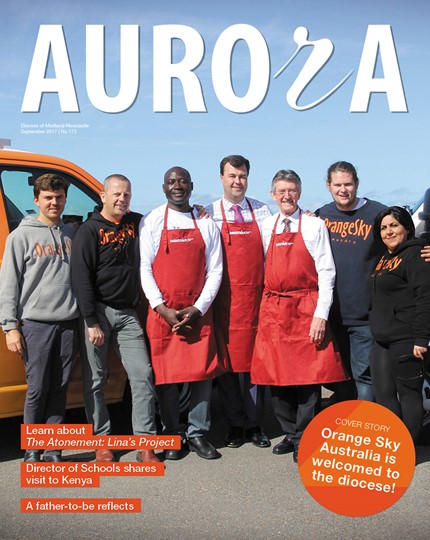If it had been an historical photo my response would have been quite different. I would have felt a certain nostalgia and would have examined it closely for details of a bygone era.
They wore lots of lace. Their chasubles were the knee-length, stiff board type I knew from the 1950s. And prominent (as their hands were joined in prayer position for this group photograph) were large embroidered maniples draped over their left arms.
Now maniples were another Mass vestment I recalled from the 50s. They disappeared following the Second Vatican Council (1962 – 1965). Originally a handkerchief or sweat-rag, they had somehow assumed a role as a sacred appendage, no longer with any practical application and no sacred role or significance. No surprise that maniples are no longer current. What, I wondered, makes some cling to vestiges of an anachronistic culture?
By contrast, I have a delighted response to cultural practices I witness in my local church today. I live and worship in a wonderfully multi-cultural community. I see people touching or kissing statues. I see them leave their shoes outside as they enter church or chapel. I see them prostrate themselves before the Lord and make significant gestures which are new to our experience of Church. I love it. I love the diversity, the richness, the freshness it brings to our community of faith.
Some of it rubs off on my practice. Some will remain other people’s expression of faith which I only observe and appreciate. What we have in common is unity in our Catholic faith. What distinguishes us is the multiplicity of expression shining out from our many cultures.
The sadness I felt as I gazed at the priests of the St Pius X Society came from their culture chains. Their faith appears locked into a culture that many see as past, extinct, and irrelevant. The basic faith they profess is none of these, of course. The Creed we share is none of these. Yet they seem unable to distinguish between Creed and bygone culture, between core Catholicism and a one-time geographically limited expression of Catholicism.
This dominant culture was often imposed disrespectfully on diverse “inferior” civilisations – sometimes attempting to annihilate legitimate cultures and their compatible customs.
What I am getting at is that core Catholicism and cultural Catholicism have to be carefully distinguished. There is an unchanging core, and there are variable optional extras. They should not be confused with each other.
Catholicism can diminish and disappear from the lives of communities and individuals if there is mere cultural adhesion to ways of expressing the faith rather than a genuine bonding with Jesus Christ, the core of our faith and religion.
So, what is core, and what is cultural in Catholicism?
As already stated and obvious, Jesus is core. All that we associate intimately and inextricably with Jesus is core. The whole Creed is core. The Mass and Sacraments are core. Scripture and the commandments to love God and one another are core.
What is cultural? Maniples are definitely cultural! Particular ways in which the core is celebrated, venerated, expressed are cultural. Head covering and styles of dress are cultural. Veneration of relics, statues, icons is cultural. Chaplets, favourite prayers and devotions are cultural. The value of all these is to be found in how closely they bring us to the core, how much they bring us to intimacy with Jesus.
Whereas core Catholicism is all good, cultural Catholicism can be good, bad, or anything in between.
While thoughts of core versus cultural were percolating in my head I read this pertinent quote from Francis Sullivan of the Church’s Truth, Justice and Healing Council which was set up to respond to the Royal Commission into Institutional Responses to Child Sexual Abuse: “Our culture grew the abusers and our culture protected the abusers and our culture for so long denied the victims.” No, it wasn’t Jesus, our faith in him, or any aspect of our Creed, that did the growing, protecting and denying. It was bad culture.
Sullivan is speaking, among other things, about the culture of clericalism which many, including Pope Francis, have decried. Priesthood is core Catholicism. Clericalism is cultural, and an aspect of our culture to be eliminated.
I give an example which illustrates the need for a clear and precise distinction to be made between core and culture in the area of clericalism. An African prelate told recently how he is spared the boarding formalities at his country’s airports when wearing clerical garb. He is asked for a blessing instead. We may be tempted to say “How nice” when we should be saying “Oh, no!” Clericalism, in this instance, could allow a suicide bomber on board. The Archbishop should insist that he, like everyone else, be subject to the procedures set in place for the common good of all. Pope Francis does not seek privilege. He even carries his own bag.
Are we good at distinguishing between core and cultural Catholicism, I wonder? I have no doubts that such ability to distinguish is grace and gift from God, given to those who pray and seek. With such a gift we evaluate everything against the core which is Christ. We evaluate our secular cultural environment with its multiple expressions and diversity, and specifically we need to evaluate our many church cultural practices − especially those we most take for granted without appropriate questioning.
A close relationship with Jesus will sharpen our focus on the heart of our Catholic faith. It will also put in perspective the cultural elements which can and do change in time and place, so that these cultural variations will do nothing but enrich and strengthen our unity with one another and the One who is the same yesterday, today, and tomorrow.























































































